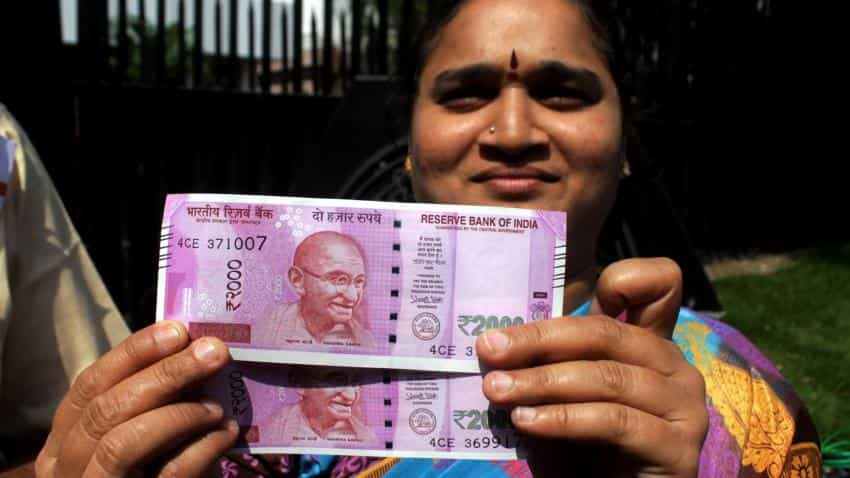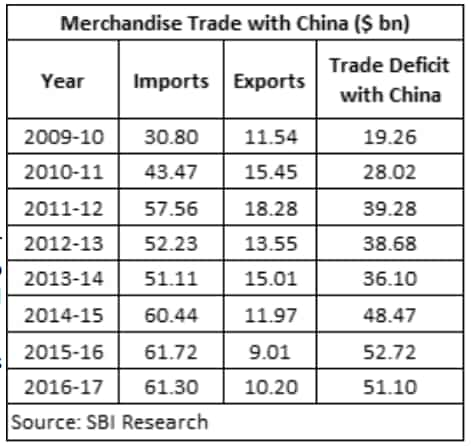Indian rupee's appreciation making matters worse for trade deficit with China
Indian rupee has appreciated by nearly 7% and has become overvalued compared to its peers - resulting in some RBI intervention.

Key Highlights:
- Rupee trades at 63-level against US dollar presently
- Indian Rupee appreciates by nearly 7% against dollar
- USD has depreciated by 9% since start of 2017
The Indian rupee is now at its two year-high and is trading at nearly 63-level against US dollar. Rupee has appreciated by nearly 7% against dollar and has outperformed emerging markets currencies since the start of the year 2017.
Three reasons are the outcome of rupee appreciation – firstly under-performance of dollar index which has depreciated by 9% in 2017, secondly Chinese forex reserves has been rising for the sixth consecutive month and climbed to $3.08 trillion in July and lastly strong foreign inflows India.
Data compiled by NSDL showed FPI's invested a total of Rs 179,802 crore between January 2017 – till date. Among which Rs 121,939 crore was invest in debt and Rs 57,863 crore in equity.
However, the impact of rupee appreciation has been deeply seen in India's balance of trade since the start of 2017.
Balance of Trade is the difference between a country's imports and exports. When imports are higher than exports it results in trade deficit for a country or a vice versa.
Gaurav Dua, Head of Research, Sharekhan said, "Appreciation of the rupee adversely impacts the export driven businesses like IT services, textiles & garments, gems & jewelry and pharmaceuticals. On the other hand, the importers tend to benefit from appreciation of the rupee against the dollar."
Exports in June 2017 stood at $23.56 billion, rising by just 4.39% compared to $21.68 billion in the corresponding period of the previous year. On month-on-month basis June exports has declined versus $ 24.01 billion in May 2017 and $ 24.63 billion in April 2017.
At the same time, imports grew by 19% to $36.52 billion in June month compared to $29.45 billion a year ago same period. Imports in May stood at $37.85 billion and $37.88 billion in April 2017.
According to State Bank of India, Indian currency has also appreciated by 3.7% against Chinese Renminbi during the same period. With trade deficit with China constituting 48% of the overall trade deficit in FY17, this is indeed a matter of serious concern for policy makers.

India runs a trade deficit with China which has increased significantly over the years. Trade deficit has risen to $51.1 billion in FY17 compared to $19.26 billion in FY10.
SBI added, "If this trend of rupee appreciation continues, thereby making goods from China cheaper, our imports from China could very well exceed the level of $61.30 billion attained in FY17."
This is not a good sign, as per SBI it can adversely impact production of these domestic industries.
Even the IIP data reveals that industries such as electrical equipment; motor vehicles, trailers and semi-trailers; fabricated metal products as well as chemical industries are showing negative growth in the past few months, stated SBI.
Rupee appreciation also results in a large importers' portfolio being unhedged. As per India Ratings, majority of the importers have 75% exposure to FX movement and also lie under the unhedged category.
SBI said, "As of now, banks have to keep aside a provision if corporates don't hedge their portfolio and the apex bank may thus think of further suitable measures that could spur market players to hedge their portfolio as any self fulfilling prophecy could lead to further rupee appreciation."
Mark Mobius, executive chairman of Templeton Emerging Markets Group at Franklin Templeton Investments told Zee Business, "Indian rupee continuing to get stronger and probably hit 60 against the US dollar by the end of the year on the back of growth in India, strong and rising reserves."
While ICICI Bank has revised its rupee outlook to 64.50 for the current fiscal year with a variation of +/- 2% from previous forecast of 65.50 by March 2018.
The bank said, " External shocks led by the Fed unwinding or any triggers from the ECB continue to remain the key risks to the outlook.” Also it added, “ We are cognizant of the widening trade deficit and likelihood of external shock as the global liquidity scenario is expected to tighten in the medium term. This is warranted to stem the appreciation bias in the currency."
“The highest ever over valuation of the Indian Rupee on 36 and 6 country basis is another consideration for Rupee intervention,” added ICICI Bank.

ALSO READ:
Get Latest Business News, Stock Market Updates and Videos; Check your tax outgo through Income Tax Calculator and save money through our Personal Finance coverage. Check Business Breaking News Live on Zee Business Twitter and Facebook. Subscribe on YouTube.
RECOMMENDED STORIES

Looking for short term investment ideas? Analysts suggest buying these 2 stocks for potential gain; check targets

Small SIP, Big Impact: Rs 1,111 monthly SIP for 40 years, Rs 11,111 for 20 years or Rs 22,222 for 10 years, which do you think works best?
10:31 AM IST









 Rupee rebounds from all-time low, gains 10 paise to close at 85.03 against US dollar
Rupee rebounds from all-time low, gains 10 paise to close at 85.03 against US dollar Rupee recovers 6 paise, hovers near all-time low at 85.07 against the US dollar
Rupee recovers 6 paise, hovers near all-time low at 85.07 against the US dollar Rupee falls 12 paise to all-time low of 85.06 against US dollar in early trade
Rupee falls 12 paise to all-time low of 85.06 against US dollar in early trade Rupee falls 1 paisa to 84.92 against US dollar in early trade
Rupee falls 1 paisa to 84.92 against US dollar in early trade Rupee value market-determined with no target: Minister of State for Finance
Rupee value market-determined with no target: Minister of State for Finance